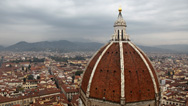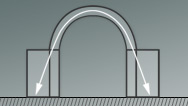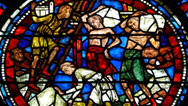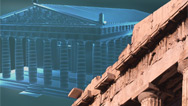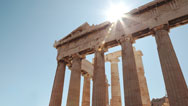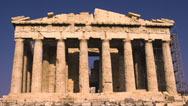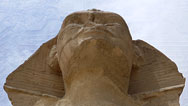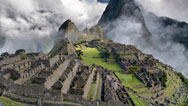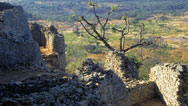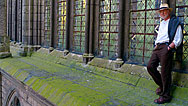
Building the Great Cathedrals
How did medieval engineers construct magnificent skyscrapers of glass and stone? Airing December 23, 2015 at 9 pm on PBS Aired December 23, 2015 on PBS
- Originally aired 10.05.11
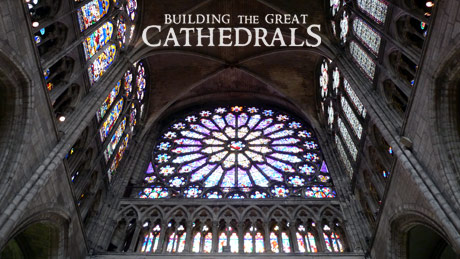
Program Description
Transcript
Building The Great Cathedrals
PBS Airdate: October 19, 2010
NARRATOR: Gothic cathedrals: giant walls of glass, in a kaleidoscope of colors, surrounded by a spider web of masonry and crowned with eerie gargoyles. These skyscrapers of stone dominate skylines for nearly 1,000 years.
How, in the Middle Ages, without the benefit of modern tools and technology, did engineers construct Gothic cathedrals? Now, experts explore a radical new theory: a hidden mathematical code, ripped from pages of the Bible, was used as a blueprint.
JACQUELINE JUNG (Yale University): People were using the proportions by which God had created the universe.
NARRATOR: But to unlock the cathedral code, investigators must strip these medieval mega-structures to their bare bones.
FRANK HELMHOLZ (Master Stonemason): Very slowly, let the pressure go.
NARRATOR: They've got to figure out how cathedrals could reach such spectacular heights and what pushed some to the brink of collapse?
Now, can these experts solve one of the greatest medieval mysteries? How on earth did they build the Gothic cathedral?
Up next on NOVA, Building the Great Cathedrals.
Taller than the ancient pyramids in Egypt, large enough to hold the Statue of Liberty; a hundred million pounds of stone, seemingly weightless, yet as heavy as the Empire State Building. This is a revolution in building: Gothic cathedrals.
From the moment they appear in Europe, about a thousand years ago, they spark an intense rivalry between cities. They consume the labor of entire towns, sometimes taking a hundred years to build. With just hand tools and stone, master craftsmen find ways to defy gravity, pushing to greater and greater heights.
But this race for height sometimes leads to disaster. One of the tallest cathedrals collapses twice. Many others still teeter on the brink of catastrophe.
STEPHEN MURRAY (Columbia University): It's frightening to see. This is the least stable bay in the entire building.
NARRATOR: How on earth did medieval builders construct these skyscrapers of stone? And what caused some to collapse? Now, two teams uncover the engineering secrets locked inside Gothic cathedrals. One team reassembles a Gothic church in California, to discover how cathedrals went up.
FRANK HELMHOLZ: This is the first time we've seen this all together, it's really amazing.
NARRATOR: Another team, in France, uses laser scanning to investigate why some of the tallest cathedrals fell down.
STEPHEN MURRAY: This is an exciting building, because it's come through a whole series of catastrophes.
NARRATOR: What pushed cathedral builders to such dangerous heights? Experts explore a radical new theory: medieval builders used sacred numbers from the Bible as a blueprint.
JOAN BRANHAM (Providence College): We can analyze medieval manuscripts that show the Temple of Solomon, and guess what it looks like? It looks like a Gothic church.
NARRATOR: Embedded in stone and stained glass, is there a hidden mathematical code that unlocks the secrets of Gothic cathedrals?
At the dawn of cathedral construction, in the late Middle Ages, around the 12th century, building with stone was dirty, difficult work. No one knows this better than these modern craftsmen. Southeast of Paris, France, they are building a medieval castle, using only traditional tools and local materials: stone, iron and wood.
They're rediscovering the same methods used to construct Gothic cathedrals.
Their castle, called Guedelon, stretches about half the length of a football field. It's part tourist attraction and part medieval construction lab.
MARYLINE MARTIN (Guédelon): We're building to understand. It's an experimental archaeological site, and the idea is to get as close as we can to the reality of medieval construction work.
NARRATOR: The team's challenge today is how to build a wall on the upper floor of the castle. The first problem is cutting through solid rock. Stonecutters find that if they hammer along natural fault lines, they can split the rocks open.
Next, masons carve the pieces into building blocks. But each weighs 150 pounds, and has to be lifted all the way up top, almost five-stories high.
From medieval manuscripts, the crew discovered that builders in cathedral times turned an ancient Roman war engine into a hoisting machine. Workers can lift six times their own weight. They call this curious contraption the "squirrel cage."
Thibaut Desjardin is trying it out for the first time.
THIBAUT DESJARDINS (Guédelon): It's harder than it looks. It's tough because there's a lot of resistance. The wheel slows down regularly, so you have to keep speeding up.
NARRATOR: Step by step, the wheel lifts the stones to the roof.
Meanwhile, another team mixes mortar. It's a long-lost recipe of burnt limestone and sand. The mortar smoothes out gaps between stones, but it's no Super Glue®.
SARAH PRESTON (Guédelon): It's a very slow-drying mortar. In fact, in the inside of these walls, where there's very little air, it could take over a thousand years for the mortar to completely dry.
NARRATOR: Instead of mortar holding the blocks together, it's something much more basic: pressure. The weight of the castle, 60,000 tons, keeps each stone in place.
But each layer of stone must be level, or the entire wall will topple. In pre-Gothic times, the only way to build tall is to construct big thick walls. So, the result is buildings that are bulky and dark.
Then, all that changes. On June 11, 1144 AD, a "who's who" of medieval France, including the king and queen, gather in the outskirts of Paris. Here, at St. Denis, the king's official church, they witness a revolution in engineering.
Brilliantly colored light streams through enormous stained glass windows, washes over impossibly slender walls, and reflects off soaring ceilings. Abbot Suger, the visionary behind St. Denis, calls his architecture "modern." Critics scoff and name it after barbarians known as the Goths. The name sticks: "Gothic."
But to Suger, his church recalls the glory of what the Bible calls God's house on Earth, the Temple of Solomon.
JOAN BRANHAM: Abbot Suger associates St. Denis with biblical prototypes, especially the Temple of Solomon. And these temples often have jewels, glass, gold set within them.
NARRATOR: To Suger, light was a symbol for God. By bringing in more light, he hoped to bring people closer to God.
Villagers living in small dark spaces must have been awe-inspired by the church's towering walls of light.
JOAN BRANHAM: Suger's walls become windows. Suger actually uses light as a building material.
NARRATOR: Amazingly, Gothic engineers built thin, super-tall walls, made, not of stone, but mostly of glass. And somehow, these walls of windows support towering ceilings of stone. How did medieval builders pull off such a dramatic transformation?
The answer may lie in this chapel, which falls somewhere between the thick, bulky walls of Guedelon and the tall, thin walls of St. Denis. The trouble is the chapel is in pieces.
In 1931, American newspaper tycoon William Randolph Hearst bought the church in Europe and shipped it, block by block, back to California. But the Great Depression stopped Hearst from ever rebuilding it. Today, that's FRANK HELMHOLZ's job, in Vina, California.
He's a master stonemason who's worked on French cathedrals.
FRANK HELMHOLZ: The stones from the monastery were taken apart about 70 years ago, stone by stone, in Spain. Right in here, we actually have a lot of the stones still stored.
NARRATOR: It's taken about a decade to sort through all these blocks. And after 800 years and shipping half way around the world, many are damaged.
FRANK HELMHOLZ: Start the blade.
NARRATOR: To resurface them, they use this three-foot power saw.
Over the last seven years, they have rebuilt the chapel's exterior walls. The team has found that the chapel is constructed with two different building techniques.
The back of the chapel is the older Romanesque style, thick and bulky. The rounded windows don't let in much light because they have to be small and narrow to support the weight of the wall. But the front of the chapel is Gothic. Similar to cathedrals, the walls are taller and thinner, with big openings to allow in more light. And the arches are a different shape: pointed.
Could this pointed arch hold the key to constructing tall cathedral walls? To find out, Helmholz and his team build a scale model of a cathedral arch.
JOHAN: So this would be SR3.
FRANK HELMHOLZ: All right, let's put that one on.
NARRATOR: This model is 1/16 the size of a cathedral arch.
FRANK HELMHOLZ: I still feel like we could do a little better here.
NARRATOR: Even though it is smaller, he still has to make sure that each of the stones is precisely aligned.
FRANK HELMHOLZ: It's a little funky up there. Keep going with two on this side, more.
NARRATOR: Here, where the stones start running diagonally, gravity comes into play, introducing a pressure known as a stress line.
In a round, Roman arch, the stress line goes mostly sideways, pushing the columns apart. If it's too tall or wide, the arch starts to sag in the middle and collapses. But the pointed arch redirects the stress line down to the ground, rather than to the sides. And that allows engineers to build higher.
FRANK HELMHOLZ: The great advantage of the pointed arch is it guides the thrust of the arch forces more downwards, rather than outwards.
NARRATOR: So, the pointed arch is the first advance that led to towering cathedrals, but even this arch has limitations. Right now, Helmholz has a problem.
FRANK HELMHOLZ: The arch is pressing outwards. You can see it in this movement here. There is something that wants to go out because the stones are pushing downwards.
NARRATOR: Even though the pointed arch redirects gravity, it creates stress at the top of the columns. It's a problem the crew will have to resolve, or the stones will hinge open and the entire arch will cave.
The forces on this scale model are just a fraction of those in a real-world structure, and 80 miles north of Paris, these forces may be pushing a great medieval cathedral to its breaking point.
In 1220, villagers in the boomtown of Amiens decide to build a new cathedral, large enough to fit their entire population of 20,000 people.
They are not alone. The opening of the king's church in St. Denis inspires dozens of towns surrounding Paris, and then throughout France, to go Gothic, each hoping to construct the tallest, most luminous building on Earth.
Like many cathedrals, Amiens is built in the shape of a cross. At its very center, workers built tall walls with pointed arches to create an enormous central bay, twelve stories high. But Professor STEPHEN MURRAY believes the race for height may have come at a steep price.
STEPHEN MURRAY: This large bay, although beautiful—it opens up the space; it creates a fabulous dramatic, almost a theatrical center to the building—but the large bay has left a structural problem.
NARRATOR: Just like the pointed arch in California, this arch is showing signs of stress.
STEPHEN MURRAY: From this level, we can really see, very easily, the extraordinary signs of structural distress in the building. The visible evidence is all those cracks and fissures. I mean, it's frightening to see.
NARRATOR: These cracks could be the first signs of catastrophe, because to the left of the damaged arch is an enormous central support column that holds up the ceiling: thousands of tons of stone. So, these cracks could be a warning that the very heart of the cathedral is in danger of collapse.
Murray is anxious to investigate. He brings in a team of scientists using the latest laser scanning technology.
STEPHEN MURRAY: What this machine can do is give you the entire superstructure. We can begin to see the deformations in the building and begin to understand its structural problems.
NARRATOR: Murray enlists the help of Andrew Tallon, a medieval architecture specialist, to scan every nook and cranny of Amiens Cathedral.
ANDREW TALLON (Vassar College): It sends a little laser beam out from its eye, and it measures—thousands of times a second—the distance between itself and whatever it's hitting. And so, it slowly pans across the wall, taking a whole series of measurements, which then are represented in three dimensions as a series of X-Y-Z coordinates.
NARRATOR: In only a matter of minutes, the laser scans the entire central space of Amiens Cathedral.
ANDREW TALLON: This is the thrilling moment of the scan, when we see the building start to appear.
NARRATOR: It's a highly accurate 3D model, a virtual cathedral. But can it reveal the lurking structural problems that threaten Amiens?
STEPHEN MURRAY: A building is a naughty thing. It misbehaves. The arches want to push outwards. The building is sometimes guilty of misbehavior that could produce collapse.
NARRATOR: To understand this misbehavior, Murray and Tallon run a structural analysis back at their lab, in New York City.
STEPHEN MURRAY: This is a whole new tool to understand exactly what's going on.
NARRATOR: They zero in on the central columns, to look for signs of damage.
ANDREW TALLON: We can measure the distance at different levels of elevation. So, we'll start at the base level.
NARRATOR: They measure the distance between the columns at three levels. If the columns are straight, the distances should be the same.
ANDREW TALLON: So, we'll take a measurement at the lowest point: 11.6 meters. So, that's our basic measurement. And if we go up a little bit, a couple meters above, three meters above, we get 11.5 meters. So we're dealing with 10 centimeters.
STEPHEN MURRAY: That is considerable.
ANDREW TALLON: That's a considerable distance. So, this is being pushed in by 10 centimeters, let's say five centimeters on each side.
NARRATOR: Right away, the model shows the stone columns are not straight. But it gets worse.
ANDREW TALLON: Let's go up to the very top of the building and measure the distance just under the high capitals. So, we'll select a point here and a point just across the way here. The distance is 11.7. So, we're dealing with fully 20 centimeters difference.
NARRATOR: The laser model reveals the columns are moving in two different directions: in at the bottom and out at the top. In both cases, the stones in the surrounding arches are pushing out and exerting pressure on the columns.
STEPHEN MURRAY: This is a recipe for disaster.
NARRATOR: Next door, structural analyst RORY O'NEILL wants to find out just how bad that disaster would be.
RORY O'NEILL (Columbia University): By entering it into a simulation system like this, we can push things to the point of their hypothetical collapse and then examine what's going on. Where are those moments in the building that the builder would lose sleep over at night?
NARRATOR: O'Neill simulates what would happen, over time, if the force of the lower arch pushes too hard on the column.
RORY O'NEILL: What's happening, now, is that all of the structure is starting to slide this way. And I'll pause it for a second, so we can go in and take a closer look. We see that the bricks are starting to separate from the arch.
NARRATOR: The cracks in the model look strikingly familiar.
RORY O'NEILL: These cracks are a tell. They're letting us know that, in fact, the wall has shifted over time.
NARRATOR: The virtual model reveals that the real cracks have formed because the arch has pushed the column to one side. O'Neill simulates what happens next.
RORY O'NEILL: It would continue to push out until a moment, at one point, it would just give way and everything would come crashing down.
NARRATOR: At the root of the problem are the stress lines in the arch.
It's the same problem FRANK HELMHOLZ needs to solve in California, with his pointed arch.
FRANK HELMHOLZ: The stress line is pushing outwards.
NARRATOR: If the crew removes the wooden frame now, the arch will collapse, because the stress line is pushing these two stones out. Helmholz needs to counter this force, so he builds a supporting arm to prop it up.
FRANK HELMHOLZ: The stress line comes down here and wants to push out. This arch is designed to counteract that.
NARRATOR: This ingenious solution is called a flying buttress.
To do its job, the buttress must be precisely placed.
FRANK HELMHOLZ: If this buttress arch is attached too high, then you still have the buckling possibility underneath here. If it's placed too low, then, up here, this can blow out this way. So, it really is important that this is placed in the right height.
Let's take off these two side pieces.
NARRATOR: It's the moment of truth. Helmholz is about to find out if his stone arch, without any mortar, will stand on its own.
His team slowly removes the wooden supports, called the centering.
FRANK HELMHOLZ: And, very slowly, let the pressure go. Great, that looks good. And I'll do the same, then let go. And there's no movement. It looks very good. It's quite exciting, actually, to see it work. It's always a miracle when you see an arch finally free from the centering.
NARRATOR: The flying buttress reaches dramatic proportions in a full-scale Gothic cathedral, rising spectacularly from the ground, an intricate spider web of masonry. With the pointed arch, the flying buttress is the second Gothic innovation that allowed medieval engineers to capture heavenly light and to reach celestial heights.
The arch and buttress make up the basic building blocks of an entire cathedral. But it's a house of cards, where the placement of every individual stone plays a critical role. To see how critical, Helmholtz moves just one stone.
FRANK HELMHOLZ: Shall we go? Here we go.
NARRATOR: Without the buttress to counter it, the sideways force of the arch pushes the column outwards and the structure collapses.
It's the same sideways force that caused this collapse that's making the central columns back at Amiens bend out of shape, threatening disaster.
Yet, to support the arch at the top of the central columns, outside, Amiens' engineers did build a flying buttress.
So what's gone wrong?
Back at their lab at Columbia University, STEPHEN MURRAY and Andrew Tallon investigate.
Their 3D model immediately reveals a critical error: the exterior flying buttress is not in the right place.
ANDREW TALLON: They've pushed it much, much too high. In other words, the flying buttress is doing precious little.
NARRATOR: The original builders placed the flying buttress too high to counteract the force of the ceiling arch pushing outwards. So, more than two centuries later, a master mason set out to fix it. He added another more solid buttress and placed it below the original, where it provides better support.
STEPHEN MURRAY: That later mason, in a sense, saved the building.
ANDREW TALLON: This lower flying buttress looks like a flying buttress should, that is, it's solid.
STEPHEN MURRAY: It's massive, it's structural.
ANDREW TALLON: Yeah, it's a prop.
NARRATOR: With new buttresses in place, the medieval builders stabilized the upper wall. But there was still no side support toward the bottom, where the wall began to crack.
STEPHEN MURRAY: By the late-Middle Ages, people were scared to death to see the enormous cracks opening up in the arcade.
NARRATOR: Medieval builders at Amiens have to find a way to support the column before it collapses. In desperation, engineers go outside the Gothic playbook of stone. They turn to metal.
Metal had rarely been used as a building material because blacksmiths didn't have the technology to make it thick or long enough. And forging iron was a slow process; it had to be hammered by hand.
Then, early in the 12th century, monks reinvent an ancient Greek tool, a hydraulic hammer. Located next to an iron mine, in the village of Fontenay, southeast of Amiens, this abbey is one of the oldest metal factories in all of medieval Europe.
Six hundred years before water-powered machinery of the Industrial Revolution, monks use a waterwheel to turn a cog that powers a 400-pound hammer.
Now workers could produce strong iron quickly and in large enough quantities to be used in building.
But could iron rescue Amiens Cathedral? Builders make an enormous metal chain of linked iron bars. The chain runs inside the wall, along the entire length of the cathedral, to hold its central columns in place.
STEPHEN MURRAY: The chain was installed red-hot, so that it would contract and pull inwards.
NARRATOR: The medieval iron band-aid worked. Today, the massive metal chain at Amiens may still be the only thing that keeps these columns from collapsing.
Iron may have saved Amiens, but ultimately, it's the mastery of engineering with stone that is the true Gothic breakthrough. With the pointed arch and the flying buttress, it was possible to build these light-filled, majestic walls.
But these walls are almost entirely glass. How are they able to support immense ceilings of stone?
FRANK HELMHOLZ: Fire it up. Okay, let's get moving.
NARRATOR: To solve this final engineering mystery, the California crew rebuilding the 12th century chapel is installing one of its last central columns.
They hoist a crowning capital into place.
FRANK HELMHOLZ: Five years ago,when we started, it was hard to imagine we would reach this place. It's the first time we see it together. It's really amazing.
NARRATOR: Twelve columns will support the stone ceiling. And next door, the crew is building the ceiling in sections.
They carefully lower the final piece, the boss stone, into place. It's a dry run to make sure everything fits together after 800 years.
FRANK HELMHOLZ: Great, so that fits. That works.
NARRATOR: The ceiling is called a ribbed vault. It's made of two intersecting pointed arches. The ribbed vault channels the weight of the ceiling to the columns, so the walls don't bear the burden.
FRANK HELMHOLZ: Since the forces are concentrated on these ribs, everything from here, all the way across to here, can be opened up for windows.
NARRATOR: The ribbed vault is the third Gothic innovation. Working with the pointed arch and the flying buttress, engineers created a skeleton that bears the weight of the building and directs it towards the ground.
Gothic craftsmen could now fill these walls with huge, colorful glass windows.
Today, glassmakers, in New York City, are trying to make stained glass the same way as those medieval craftsmen. The basic process hasn't changed.
They start with the most elemental chemicals.
DANNY O'SHEA (Glassmaker): This is where a stained glass window begins. The basic recipe to make glass is this white powder, here. It's basically pulverized quartz crystal, various metals and soda ash, which is burnt vegetable matter.
NARRATOR: Glassmaker DANNY O'SHEA shovels the chemical mixture into a furnace that is heated to a scorching 2,330 degrees, hotter than volcanic lava.
To color the glass, medieval designers had to be craftsmen and chemists, mixing metal into the molten mass.
MICHAEL DAVIS (Glassmaker): They were aware that different metals, added to the glass mixture, would give different colors. A copper can be used to give green. It can also be used to give red; cobalt, blue; selenium is, like, an orange and a yellow.
NARRATOR: With color in place, they give the glass its first shape. O'Shea blows through a steel tube called a blowpipe, as MICHAEL DAVIS begins to shape the mass.
MICHAEL DAVIS: As you're turning, the thing is just getting wider. It wants to open. It's, kind of, a very natural thing for it to do.
NARRATOR: Spinning the glass, he works it into a disc.
Using these techniques, medieval glass builders construct a kaleidoscope of colors, from which they create enormous, intricately detailed stained glass windows like never before.
These walls of glass depict narratives from the Bible, like Adam and Eve, Noah's Ark and the Resurrection of Jesus Christ.
In an age when few people can read and write, stained glass windows become the multimedia stories of their day, the Bible written in light.
MICHAEL DAVIS: They were a revelation to the people that would go to a church and see the colored light. They were probably just marveling, like, "What is this? This is incredible." And I think it was moving. I mean we're still moved by them. I'm still moved by them.
NARRATOR: These vast spaces, surrounded by towering walls of colored light, lifted medieval minds out of the dirt and darkness of daily life, creating an otherworldly experience.
JACQUELINE JUNG is an expert on Gothic cathedrals.
JACKIE JUNG: What would have impressed an ordinary visitor the most is the incredible size and scale. They would hear the Mass performed, experience all the sights the sounds, the aromas of incense. People could really experience, vicariously, Heaven on Earth.
NARRATOR: The purpose of these immense, sacred spaces was spiritual: to bring ordinary people closer to God. Yet, cathedrals would have been impossible without the technological innovations of the pointed arch, flying buttress and vaulted ceiling.
But these engineering innovations interact in complex ways. And in the quest for heavenly height, earthly limitations brought some cathedrals crashing to the ground.
While Amiens Cathedral is under construction, just 35 miles away, the townspeople of Beauvais want to build their own stone skyscraper, bigger and more beautiful than their neighbor.
STEPHEN MURRAY: We're seeing the most beautiful cathedral of Gothic. This building takes off, like a rocket ship.
NARRATOR: But Beauvais' height comes at a cost.
High above these churchgoers are modern braces that may be the only thing keeping the cathedral from collapsing; an unsettling reminder of a medieval disaster.
STEPHEN MURRAY: On Ascension Day in 1573, there was a service being celebrated in the church. Stones began to fall. There was a solemn procession taking place. The clergy slowly began to speed up their pace. They ended up rushing out of the cathedral in a cloud of dust.
NARRATOR: Miraculously, the only injury was a broken arm. But, this wasn't the first time the church collapsed. During construction, in 1284, part of the ribbed vaulted ceiling, twelve stories high, came crashing down.
The building's columns, or piers, continue to be plagued by structural problems to this day.
STEPHEN MURRAY: An unstable pier, an overhang, the pier is buckling to the west. These are incredibly slender. Here you've got a very fragile pier, totally inadequate. This is very, very sick. This is a recipe for disaster.
NARRATOR: And Beauvais wasn't the only town courting disaster. Regional rivalry drove many Gothic builders to ever more dangerous heights, but why?
Some experts suspect they were motivated by something beyond earthly bragging rights. For hidden within the dimensions of the greatest cathedrals may be a secret mathematical code that could provide the answer.
At Notre Dame of Paris, perhaps the best-known Gothic cathedral, Stefaan van Liefferinge, a physicist turned art historian, uses a laser scanner to investigate.
He measures the height of the church's two levels. Each measures 32.8 feet. But medieval builders used a different unit of measurement.
STEFAAN VAN LIEFFERINGE: If you translate it in Royal feet, which is the medieval unit, then that would be about thirty Royal feet for the lower level, and thirty Royal feet for the higher level.
NARRATOR: The combined height is 60 Royal feet. These figures, 30 and 60, are strangely familiar to van Liefferinge. At one of France's oldest libraries, the Bibliotèque Mazarine, he searches a medieval book written by the priest in charge of building Notre Dame.
STEFAAN VAN LIEFFERINGE: What we have here is a manuscript from the turn of the 12th century which is a text that was composed by the chancellor of Notre Dame, Peter Comestor.
NARRATOR: Called the Historia Scholastica, the priest wrote this book during the cathedral's construction. He fixates on a passage in the Old Testament: a detailed description of the Temple of Solomon, in Jerusalem, which the Bible refers to as God's house on Earth. Here, van Liefferinge finds an intriguing clue.
STEFAAN VAN LIEFFERINGE (Translating from Latin): "It was thirty cubits high, up to the first floor, upon which a second dwelling was built up to the second floor, also of thirty cubits.
NARRATOR: This manuscript reveals that, to the builders of Notre Dame, the dimensions of Solomon's Temple were profoundly important: 30 cubits to the first level, and 60 cubits to the second level. These numbers are built into Notre Dame.
STEFAAN VAN LIEFFERINGE: An interesting correspondence here, a very intriguing correspondence here.
NARRATOR: Are these numbers purely coincidence, or did medieval builders intentionally encode sacred numbers from the Bible into their cathedrals?
Just southwest of Paris, clues are embedded in the crown jewel of Gothic architecture, Chartres Cathedral. The stained glass here, most of it 800 years old, is world famous. But Chartres has Bible stories etched, not in only light, but also in stone.
These intricate, exterior statues are staples of Gothic cathedrals, finishing flourishes that took dozens of carvers decades to complete. But at Chartres, alongside statues of Jesus, Mary and the Apostles, Gothic expert JACQUELINE JUNG investigates something completely unexpected: Greek and Roman scientists, who pre-date Christianity by hundreds of years; among them Aristotle, Euclid and Pythagoras, the great mathematician.
These ancient pagans were revered by medieval priests at Chartres.
JACKIE JUNG: The Cathedral of Chartres was filled with some of the leading thinkers of this time, who are, themselves, steeped in classical philosophy, science and literature, and were bringing these ideas to Christian theology, in ways that were really quite new.
NARRATOR: While the cathedral was being built, priests at Chartres studied classical Greek and Roman ideas. Medieval priests seized on the idea that the supreme beauty of the universe is based on perfect proportions and ideal numbers. They saw God as the supreme mathematician, a divine geometer who used sacred dimensions.
JACKIE JUNG: People were interested in using numbers as a means of figuring out the proportions by which God, himself, had created the universe.
NARRATOR: Medieval priests found numbers in the Bible that they believed were God's sacred dimensions.
If they used those numbers in cathedral building, can experts find them today?
On the hunt for divine dimensions, STEPHEN MURRAY returns to Amiens, where builders rescued the cathedral with an iron chain. He starts by measuring the area at the very center of the cross, where the four central columns form a square.
STEPHEN MURRAY: The geometric code that gives the shape of this building involves a great square that sits right here in the middle.
NARRATOR: Each side of the central square measures almost exactly 50 Roman feet, the unit of measure used by the builders in Amiens. Fifty also happens to be an important number from the Bible. God tells Noah to build an ark that is 50 cubits wide, to save him from the flood.
STEPHEN MURRAY: Noah's ark was 50 cubits. This is 50 feet. And this lies at the heart of the building.
NARRATOR: Like at Notre Dame, it looks as if engineers at Amiens encoded a measurement from the Bible into their cathedral.
Murray and Tallon turn to the laser scan models.
Using this technology, for the first time, they can measure the height of the cathedral down to the nearest millimeter.
STEPHEN MURRAY: And so, let's see if we can choose one of the keystones and drop a line down to the floor.
ANDREW TALLON: Alright, we'll get the distance down to the pavement below.
We get a distance of 42.55 meters.
NARRATOR: Some quick math converts modern units to medieval units and produces another divine figure: 144. In the New Testament, Heaven is called the City of God. It's height: 144.
STEPHEN MURRAY: This is the Book of Revelation, the vision of Saint John the Divine: As John measures the city, he finds it's 144 cubits.
NARRATOR: Amazingly, at the dedication ceremony for the opening of Amiens Cathedral, the bishop read aloud the very same passage from the Book of Revelation that describes the divine height, 144.
STEPHEN MURRAY: So we're dealing, in the building, with, clearly, a number that expresses some kind of object of desire. They wanted 144.
NARRATOR: Their search for divine dimensions continues at Beauvais, the cathedral that partly collapsed. They measure the height.
ANDREW TALLON: ...check the measurement, and it is 144.3.
STEPHEN MURRAY: ...the same number at Beauvais. They're aiming at this celestial number.
NARRATOR: The builders at both Amiens and Beauvais used the height of God's heavenly city in the Bible to design the height of their cathedrals.
Along with the discovery of Solomon's Temple encoded at Notre Dame, and Noah's Ark at Amiens, experts have uncovered compelling evidence that some medieval architects used measurements from the Bible as a blueprint for building their cathedrals.
Using sacred numbers, Gothic engineers strived to make cathedrals a kind of Heaven on Earth, a sacred place for transporting medieval minds from their daily lives of toil to the lofty heights of eternity.
Even the floor plan of the cathedral is the ultimate Christian symbol of salvation, the crucifix.
STEPHEN MURRAY: The building is a vehicle. It takes you somewhere else. A cathedral, in a sense, is a medium; it's a transport. It takes us to heaven.
NARRATOR: But in striving for godly dimensions, builders were caught up in a very human race.
At both Amiens and Beauvais, engineers built cathedrals 144 units high. But the builders at Beauvais used a clever trick to reach the top—a different unit of measure, instead of the Roman foot—the slightly longer Royal foot. Thus, Beauvais reached heavenly dimensions and built the tallest cathedral on Earth.
But that quest for height came at the price of structural instability, and to this day, Beauvais Cathedral remains unfinished.
STEPHEN MURRAY: This is a building that has suffered all kinds of architectural setbacks, and yet one which remains, still, to my mind, the most beautiful of all the buildings of French Gothic.
NARRATOR: Fueled by faith and guided by daring engineering, Gothic architects forever changed how we build big. Pushing the limits of their technology, and driving to new heights, cathedral builders created sacred spaces that still inspire people to this day.
Broadcast Credits
Building The Great Cathedrals
- Produced And Directed By
- Scott Tiffany
- Written And Produced By
- Gary Glassman
- Edited By
- Rob Tinworth
- Content Producer
- Tristan Barako
- Coordinating Producer
- Maureen Barden Lynch
- Associate Producer
- Ben Sweeney
- Narrated By
- Jay O. Sanders
- Music
- Ed Tomney
- Animation
- Handcranked Productions
- Directors Of Photography
- Mark Daniels
John Chater
Jeremiah Crowell
Mathieu Czernichow
John Hazzard - Still Photography
- Mark Bussell
- Assistant Camera
-
Mathieu Lamand
Justine Bourgade - Sound Recordists
- Adriano Bravo
Xavier Griette
Stéphane Kah
Ryan Kennedy
André Rigaut
Juan Rodriguez - Gaffers
- Adam Orellana
- Key Grips
-
Eric Labosse
Lionel Antonio - Production Managers
- Sacha Guillaume
Adrien Horvath - Crane Operator
- Eric Daubry
- Production Assistants
- Siena Brown
Zach Kuperstein
Melody Mitchell - Voice Over
- Mario Brassard
Tanya Pushkine - Sound Design
- Geof Thurber
- Sound Mix
- Greg Mccleary
- Production Accountant
- Bernard W. Klimaj
- Legal Counsel
- Chace, Ruttenberg & Freedman
- Translations
- Marie Wisecup
- Interns
- Charlotte Oldsman
Robert Montagano
Madeline Wisecup
Theresa Zeitz-Lindamood - Archival
-
The Bridgeman Art Library International
Corbis
©DeA Picture Library / Art Resource, NY
Jose Miguel Merino Decaceres
Erich Lessing / Art Resource, NY
Giraudon / Art Resource, NY
The Pierpont Morgan Library / Art Resource, NY
UCLA Film & Television Archive - Special Thanks
- Abbey Of New Clairvaux
Professor Peter Allen
Philip Ball
Dr. Paul Blaer
Jacques Blanrue
Sheila Bonde
Centre Des Monuments Nationaux
Chantier Medieval De Guedelon
Columbia Robotics Laboratory
Columbia University
Concept Link, Ltd.
Cornerstone Carving
Gilles Fresson
Leica Geosystems
Jean-Lucien Guenoun
Clark Maine
Austin Reiter
Serge Santos
Arnaud Timbert
Venturella Studios - For Telfrance
- Executive Producers
- Yves Jeanneau
Christine Le Goff - Line Producer
- Isabelle Lemonnier
- For Arte France
- Head Of Specialist Factuals Department
- Hélène Coldefy
- NOVA Series Graphics
- yU + co.
- NOVA Theme Music
- Walter Werzowa
John Luker
Musikvergnuegen, Inc. - Additional Nova Theme Music
- Ray Loring
Rob Morsberger - Post Production Online Editor
- Michael H. Admundson
- Closed Captioning
- The Caption Center
- Publicity
- Eileen Campion
Victoria Louie
Karen Laverty - Marketing
- Steve Sears
- Researcher
- Kate Becker
- Production Coordinator
- Linda Callahan
- Paralegal
- Sarah Erlandson
- Talent Relations
- Scott Kardel, Esq.
Janice Flood - Legal Counsel
- Susan Rosen
- Post Production Assistant
- Darcy Forlenza
- Associate Producer Post Production
- Patrick Carey
- Post Production Supervisor
- Regina O'Toole
- Post Production Editors
- Rebecca Nieto
- Post Production Manager
- Nathan Gunner
- Compliance Manager
- Linzy Emery
- Development Producer
- Pamela Rosenstein
- Supervising Producer
- Stephen Sweigart
- Business Manager
- Joseph P. Tracy
- Senior Producer and Project Director, Margret & Hans Rey / Curious George Producer
- Lisa Mirowitz
- Coordinating Producer
- Laurie Cahalane
- Senior Science Editor
- Evan Hadingham
- Senior Series Producer
- Melanie Wallace
- Executive Producer
- Howard Swartz
- Managing Director
- Alan Ritsko
- Senior Executive Producer
- Paula S. Apsell
A Providence Pictures Production for NOVA and WGBH Boston in Association with Telfrance and ARTE France
© 2010 WGBH Educational Foundation All Rights Reserved
- Image credit: (flying buttress) © Mark Bussell/Providence Pictures
Participants
- Joan Branham
- Providence College www.providence.edu/art/history/branham.htm
- Michael Davis
- Glassmaker michaeldavisstainedglass.com/index.html
- Thibaut Desjardins
- Apprentice, Guédelon
- Frank Helmholz
- Master Stonemason www.stonecarvingcraft.com/about.html
- Jacqueline Jung
- Yale University https://webspace.yale.edu/jung/
- Maryline Martin
- Site Director, Guédelon www.guedelon.fr/en/the-guedelon-adventure/the-story-begins_01_02.html
- Stephen Murray
- Columbia University www.columbia.edu/cu/arthistory/html/dept_faculty_murray.html
- Rory O'Neill
- Columbia University
- Danny O'Shea
- Glassblower
- Sarah Preston
- Instructor, Guédelon
- Andrew Tallon
- Vassar College art.vassar.edu/faculty/antallon.html
- Stefaan Van Liefferinge
- University of Georgia art.uga.edu/people.php?id=5061
Preview
Full Program
Full program available for streaming through
Watch Online
Full program available
Soon

